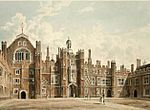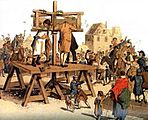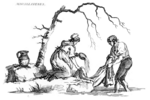William Henry Pyne facts for kids
William Henry Pyne (born in London in 1769 – died in London on May 29, 1843) was a skilled English writer, illustrator, and painter. He also wrote under the pen name Ephraim Hardcastle.
Pyne learned his art at the drawing academy of Henry Pars in London. He first showed his artwork at the Royal Academy in 1790. He was especially good at drawing beautiful scenes with groups of people. He often used pen, ink, and watercolour for his art. In 1804, Pyne helped start the Royal Watercolour Society.
Contents
William Pyne's Art and Books
Pyne created many interesting works during his life. He was known for his detailed illustrations and writings.
Famous Publications
One of Pyne's important books was The Costume of Great Britain. It came out in 1805. This book had 60 paintings showing different types of people. It included professional workers and everyday scenes. The publisher William Miller released it.
This book caught the eye of another publisher, Rudolph Ackermann. Pyne then worked on many of Ackermann's projects. He drew pictures and wrote for them. He wrote the text for the first two volumes of The Microcosm of London. This was a very popular book known for its illustrations.
Royal Residences Project
From 1816 to 1819, Pyne published a large book called The History of the Royal Residences. He published this book himself. It was filled with 100 detailed pictures. These pictures showed the outside and inside of royal homes. Some of these homes included Windsor Castle, St. James's Palace, Carlton House, Kensington Palace, and Hampton Court Palace.
This big project caused him some money problems. He faced financial challenges more than once. He passed away in 1843 without much money.
Writing as Ephraim Hardcastle
William Pyne also wrote under the name Ephraim Hardcastle. He wrote interesting articles about art for the Literary Gazette. In 1824, these articles were put together into two books. They were called Wine and Walnuts, or After-dinner Chit-chat.
He also wrote for other magazines. In 1825, he published a novel. It was titled The Twenty-ninth of May, or Rare Doings at the Restoration.
Pyne's Legacy and Family
Many of Pyne's watercolour paintings are now in major museum collections. These include the Royal Collection and the British Museum.
His son, George Pyne (born around 1800 or 1801 – died in 1884), also became an artist. George was a watercolour painter too. He also wrote books about drawing and how to use perspective in art.
Gallery
-
St George's Chapel, Windsor Castle from the Altar, from Pyne's Royal Residences, 1819.








